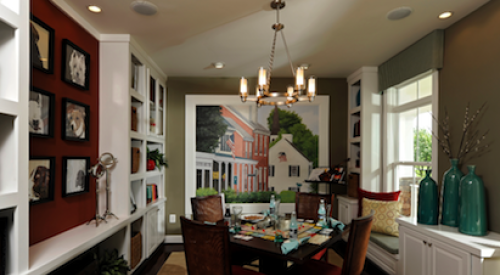| Simple affordable treatments can make a rich statement to first time buyers. |
We have all explored certain rooms in certain homes, sometimes by invitation, sometimes because we simply find ourselves wandering down a hall or into a library or music room. Some of us cannot resist examining bookcases to see what our hosts read or have read. We all look around us when we are in a home that is not ours. The reasons are as complex, and as basic, as we are. We are hunting for clues about how these people live and ways to appreciate aspects of their humanity that we were perhaps not aware of before coming into their home. Some of us look to see how we can adapt some of their ideas to our habitats. We are humans — the curiosity and inquiry are ongoing and automatic.
Make the most of human nature in your new home sales centers. In doing so, you will give people enjoyable, rewarding reasons to linger in your models — a major step in persuading them to consider buying one of your homes. And if you do the proper research ahead of time, you will achieve the more important objective, which is to demonstrate a strong and empathetic understanding of your buyers that helps them click with your models and begin to picture themselves as owners of one of your homes.
For the merchandiser, the goal should be simple. We want to show buyers a home, not a house with stuff in it. Interest, inspiration and information can all be conveyed with art. Without it, you can have OK models, the same way doctors’ offices are OK (can you recall anything on those walls?).
So think about what you will put on the walls and in the niches, and why. Some pointers: Personalize the profile — get your demographic information from the most reliable market research sources. Then bring it to life with psychographic research that pinpoints the likely buyers for your homes. Example: You know your market and that your new homes are for first-time buyers. Demographics tell you they do not have lots of money to devote to art. Nor have they lived long enough to gather many pieces; many have no desire to be collectors.
Psychographics peel more layers from the onion, adding dimension and perspective to the design and merchandising discussions. You need this information to discover how your buyers live, what they like to do in their leisure time, whether they prefer the downtown theater and cafes, shopping malls and backyard barbecues, or both. What do they read? Where do they buy clothes? Where do they go on vacation? What are their favorite movies?
Armed with this knowledge, you can move on to the universal: A stylish statement is always appropriate for a new home. For first-time buyers, choose themes that reflect the lifestyle information you have gathered, and keep treatments affordable. Posters work well for virtually any space that will accommodate wall art. Choose clean and simple frames, perhaps from Ikea and Aaron Bros. or similar retail stores that your buyers use. Include one or two pieces with more significance and substance, perhaps tied to your locale’s history or to the far-off land of a significant vacation destination. These pieces should demonstrate more sophistication and higher perception of cost; these are the pieces that say, “This one is important to us.”
Art in move-up models should show the growing taste and discernment of these buyers. Again, to send an effective message, focus more on understanding the finer points of their lifestyle than on assuming that ages and income brackets tell all. Are they reading Architectural Digest or Money? Do they travel, or are they focused on their children’s accomplishments and projects? Are they casual, or do they appreciate formality?
These answers guide your model homes, and the same should be true of the model home art. Family galleries can evoke a sense of multigenerational history and are very useful in transitional spaces. A classic artist whose work complements the architectural theme might be particularly effective with buyers who want formality in the home; an American artist might be ideal for neotraditional architecture. One or two pieces that bring eclectic depth to the general theme add realism. Remember that few of us live with everything perfectly coordinated and perfectly matched.
| Solid demographics with psychographic research can add dimensional perspective to interiors. Examples include a room for pre-teen girls and a more whimsical music room.
Across all profiles, art addresses a hunger for individual, non-formula living environments. |
|||
Empty nesters are frequently involved with artistic pursuits, as a hobby or new vocation, and with more time to spare, their level of involvement means your model should show more than a hint. I know of a newly retired executive with a major oil company who has returned to his loves of pottery and underwater photography, which he dabbled with at the start of his career and can now resume. He is not only throwing his own pottery but using his wealth to create a gallery and studio for ceramists in his upstate New York retirement town. Model homes for people like him can and should demonstrate this active involvement in the arts.
Across all profiles, our firm sees more emphasis and interest in art that reflects the owners’ personalities, family histories and aesthetic preferences, and a hunger for individual, nonformula living environments. This means feeling free to have art in every room; why shouldn’t the cook have something pleasing to see?
We also see consistently high enthusiasm for images that refresh by encouraging reflection. Landscape photography is a perfect example, offering a respite from the “real world,” encouraging the viewer to turn inward for a moment and to contemplate natural beauty. With this and other themes, black-and-white photography is assuming major importance. In large or small scale, it makes people stop and look.
Whatever the solutions for model home art, remember that impact is not the only goal. Via humor, whimsy and a dash of sentimentality, use your models to convey affection for the human spirit.










